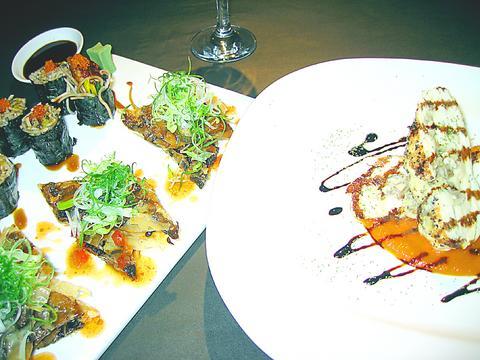Wicked might be located in the wilderness of Neihu's fast expanding and out-of-the-way business district, but walk through its doors on any given day and you'll find an oasis of culinary delights awaiting you within.
Opened in late March by Taiwanese-American sisters Helen (

PHOTO: GAVIN PHIPPS, TAIPEI TIMES
It may be straining for a classy edge, but there is no pomp and circumstance at Wicked. It's the type of place where diners can choose to make a fuss and dress up or simply walk in wearing shorts and a T-shirt.
Partly because of this, it's no wonder the dining house has already built up a reputation as the place to eat and be seen by its hardcore of regulars, that include business suits, families and local residents alike.
A graduate of San Francisco's California Culinary Academy and a veteran, albeit a young one, of the award winning Gary Denko Restaurant, Linda's ability to add original twists and turns and give new meaning to Euro-Asian cuisine is seemingly limitless and in a league of its own.
Wicked offers diners a modest, yet exciting selection of food, that combines Japanese, French, Californian and even South Korean flavors and culinary aesthetics.
Appetizers include the unique and mouthwateringly flavorsome soba unagi sushi (NT$220), or soba noodles with eel wrapped in seaweed, the light and crispy shitake mushroom spring rolls (NT$180), the hugely popular seaweed coated popcorn shrimp (NT$240) and the ginger sesame crusted Ahi tuna with citrus sauce (NT$360).
The appetizers are great but even with just six main courses, diners will be hard pressed to choose which savory masterpiece to chow down on. Be it the fantastically tender caramelized mushroom and onion stuffed chicken with red pepper coulis (NT$380), the walnut crusted salmon with corn relish sauce (NT$430) or Wicked's trademark dish, the spice crusted lamb chops with mango chutney (NT$480), all of them make for fantastic, sumptuous and mouthwatering dining.
The bottom line is that some truly wicked dishes come out of the kitchen and the joint is a must-visit for any food-loving city slicker looking for new and original culinary extravagances and experiences.

The canonical shot of an East Asian city is a night skyline studded with towering apartment and office buildings, bright with neon and plastic signage, a landscape of energy and modernity. Another classic image is the same city seen from above, in which identical apartment towers march across the city, spilling out over nearby geography, like stylized soldiers colonizing new territory in a board game. Densely populated dynamic conurbations of money, technological innovation and convenience, it is hard to see the cities of East Asia as what they truly are: necropolises. Why is this? The East Asian development model, with

June 16 to June 22 The following flyer appeared on the streets of Hsinchu on June 12, 1895: “Taipei has already fallen to the Japanese barbarians, who have brought great misery to our land and people. We heard that the Japanese occupiers will tax our gardens, our houses, our bodies, and even our chickens, dogs, cows and pigs. They wear their hair wild, carve their teeth, tattoo their foreheads, wear strange clothes and speak a strange language. How can we be ruled by such people?” Posted by civilian militia leader Wu Tang-hsing (吳湯興), it was a call to arms to retake

This is a deeply unsettling period in Taiwan. Uncertainties are everywhere while everyone waits for a small army of other shoes to drop on nearly every front. During challenging times, interesting political changes can happen, yet all three major political parties are beset with scandals, strife and self-inflicted wounds. As the ruling party, the Democratic Progressive Party (DPP) is held accountable for not only the challenges to the party, but also the nation. Taiwan is geopolitically and economically under threat. Domestically, the administration is under siege by the opposition-controlled legislature and growing discontent with what opponents characterize as arrogant, autocratic

When Lisa, 20, laces into her ultra-high heels for her shift at a strip club in Ukraine’s Kharkiv, she knows that aside from dancing, she will have to comfort traumatized soldiers. Since Russia’s 2022 invasion, exhausted troops are the main clientele of the Flash Dancers club in the center of the northeastern city, just 20 kilometers from Russian forces. For some customers, it provides an “escape” from the war, said Valerya Zavatska — a 25-year-old law graduate who runs the club with her mother, an ex-dancer. But many are not there just for the show. They “want to talk about what hurts,” she